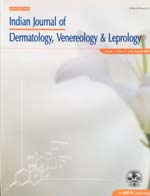
|
Indian Journal of Dermatology, Venereology and Leprology
Medknow Publications on behalf of The Indian Association of Dermatologists, Venereologists and Leprologists (IADVL)
ISSN: 0378-6323
EISSN: 0378-6323
Vol. 72, No. 3, 2006, pp. 211-214
|
 Bioline Code: dv06070
Bioline Code: dv06070
Full paper language: English
Document type: Research Article
Document available free of charge
|
|
|
Indian Journal of Dermatology, Venereology and Leprology, Vol. 72, No. 3, 2006, pp. 211-214
| en |
Brief Report - Langerhans cell histiocytosis of skin: A clinicopathologic analysis of five cases
Punia RajpalSingh, Bagai Maneesh, Mohan Harsh, Thami GP
Abstract
Background and Aims: Langerhans cell histiocytosis (LCH) is a rare proliferative disorder of histiocytes characterized by a proliferation of abnormal and clonal Langerhans cells. We retrospectively studied clinicopathologic features of this disorder in five cases.
Methods: Clinical and histopathological findings of five cases of cutaneous LCH were reviewed based on the hospital records.
Results: The age of patients ranged from 28 days to 5 years and M: F ratio was 1:1.5. Clinically, the diagnoses suggested were histiocytosis, varicella, transient neonatal pustular melanosis, keloid, sarcoidosis, seborrheic keratosis and LCH. The most common type of skin lesion was a generalized papular lesion. Histologically, all cases showed aggregates of large mononuclear histiocytes (Langerhans cells) with reniform, irregular, cleaved nuclei and abundant eosinophilic cytoplasm. There was multi-systemic involvement in two patients and single-system involvement in three patients.
Conclusion: Cutaneous lesions may be the sole presenting feature of LCH. Diagnosis is based on demonstration of S-100 positive histiocytes.
Keywords
Langerhans cell histiocytosis, Histiocytosis
|
| |
© Copyright 2006 Indian Journal of Dermatology, Venereology and Leprology.
Alternative site location: http://www.ijdvl.com
|
|
